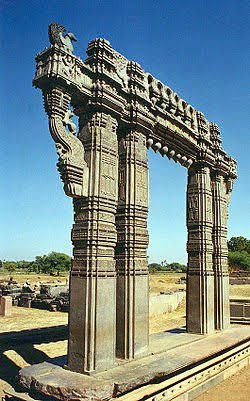Asaka – The southern most Mahajanpada
- Ancient history Asian history
 historified
historified- October 13, 2022
- 0
- 762

History teaches us a lot about places and our culture, but do we ever notice and value the contribution it has given to the world of literature and philosophy? Most of us do not, and just to test on how much you know about history, do you know the meaning of the word Janapada?
The word “Janapada” has been derived from the ancient language and books of Sanskrit. According to regarded priests and philosophers, it is a tatpurusha complex term, that is a word which has two terms attached within it. In case of “Janapada” the two words are “Jana” meaning people, and “Pada” meaning foot. This word basically depicts the time of Indo-aryan civilisation, that is somewhat near and after 1900 BCE. This word has been used and named as such to emphasize on the importance of kingdom, territory and the population of people all together at the same time with equal importance.

It has been told in history that during the 8th century BC, India was classified into approximately five regions namely : the Madhyadesha (which refers to the Middle country.); the Pratichya ( that is the western lands.) ; the Prachya (that is the eastern region/lands) ; the Uttarapatha (the land in the north of Vindhyas) ; the Dakshinapatha (the land south of Vindhyas). Some of these janapadas soon grew into mahajanapadas with more than one urban settlement. Mahajanapadas in literal sense means great or huge kingdoms. After the Vedic period declined, and as per the sources of history there were 16 Mahajanapadas or Great kingdoms to be precise. The lifes of these people who lived in these areas were simple, the methods of land grabbing was initiated because unlike other times, this time they permanently wanted to settle at a place. These settlements gave rise to well-planned communities known as Mahajanapadas or Janapadas.
These mahajanapadas mainly stretched from modern day Afghanistan till modern day Bangladesh and thus covered approximately the whole area of the Indo-Gangetic plains, during the sixth century BCE. This was also the time when Buddhism was rising in India and thus a significant amount of this era has been mentioned and derived from the ancient Buddhist texts. The legal and ideological outfit in these mahajanapadas was supported by a welldefined caste system under which the producers were saddled with economic obligations as well as social disabilities. The era represented a transition from a semi-nomadic tribal society to an agrarian-based society. These janapadas and mahajanapadas played a very vital role in the epics of Mahabharata and Ramayana as well. The sixteen mahajanapadas that are mentioned are namely : Anga ; Magadha ; Kasi ; Kosala ; Vajji ; Malla ; Chedi ; Vamsa ; Kuru ; Pancala ; Maccha ; Surasena ; Asaka ; Avanti ; Gandhara ; Kamboja.

Asaka, or Asmaka as called in sanskrit, was a Mahajanapada in ancient India, which existed between 700 BCE and 425 or 345 BCE or in other words, to exist in those days when the word Janapada was formalised. It was considered to be one of the sixteen mahajanapadas of ancient times according to the Buddhist texts Anguttara Nikaya. This janapada was located around and between the great Godavari river and its capital was called Potala. In Telangana it was recognized as Bodhan, the Godavari was situated between Telangana and Maharashtra and thus it has been presumed that the kingdom also lay there as well.

History tells us that Asaka kingdom used to exist at the time of the Brahmanas. Asaka was the only mahajanapada that was located towards the southward direction of the Vindhya Range and of a place named Dakshinapatha. Asaka was also parallel to the districts of Nizamabad and small portions of Adilabad which is in Nanded and also in Telangana. There was been lot of history attached with the name of Bodhan as well. It has been said that the title of Bodhan has actually originated from the word “Bhoodaan” which basically means “land which is given to the poor people as donations.” Potali currently lies under the territory of Nandura Tehsil. It has been read that Brahmadatta was one of the rulers of Potali, which was the capital of Asaka in those days. A Buddhist, named Mahagovinda Suttanta had mentioned the rule of Asaka by Brahmadatta later. The word Asaka means gem or stone in Sanskrit. It was named this because, there were quite a few findings and discoveries of various stones and hillocks in the region of Asaka. It has also been presumed that during the early days there was a dense meteoroid fall in the Asaka region approximately 10 to 20 million years before this civilisation. Puranas have remarked Asaka as one of the most powerful and dominated territories of the Nandas during the time frame of 4th and 5th century BCE. Asaka was considered to be one of the most important water sources during those days.
According to myths and one story given in the Jatakas, there was once a King named Kalinga of Dantapura. The King of Dantapura had challenged Aruna, the Asaka King of Potali region to a war. The former had lost the battle much to their dismay, while the latter remained victorious. However all these bitterness were at once resolved when later the Kalinga’s daughter was married to the Asaka King. Since then, the two kingdoms bonded over and started a story of friendship. The Hathigumpha Inscription at Kharavela, also mentions tales of Asaka. The inscription mentions that Kharavela had sent a huge army in the westward direction to attack Asikanagara which was located in that region. This is not all, Asaka is quite renowned due to it’s environment and resources and also because of the important roles it played in the great epics, that is the Mahabharata and Ramayana. Asaka was located at a region which was close to the centre and thus other janapadas also noticed it because of this.

It is also known in Buddhist literature for the Saptashati story of King Hala. Asaka is mentioned in the Vayu Purana, Asaka and Mulaka were by the Ikshvaku dynasty, and its prince Asaka was a vassal of Kashi.
Mahapadya Nanda (345 -329) annexed it to Magadha, and only Videha, Kuru, Panchala, Asaka were also given the title of ‘destroyer of Kshatriyas’.


